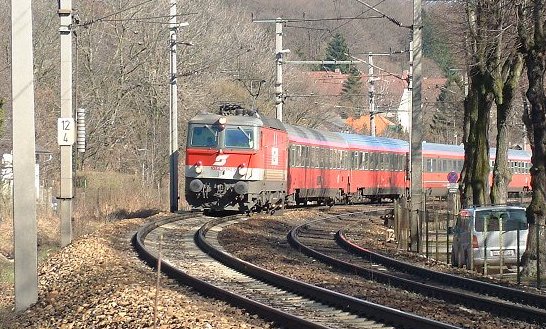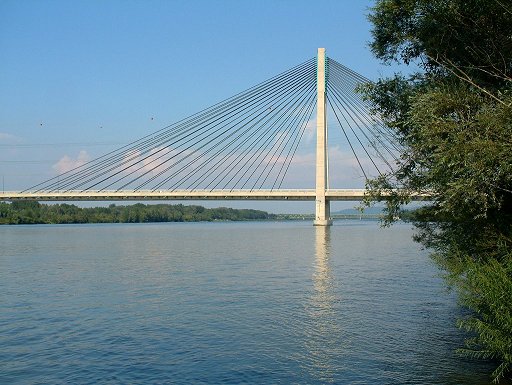| This Web book is based on public domain material provided by the US government and is available in several versions. See the editorial for more information. |

|

Home  The Economy The Economy  Structure of the Economy Structure of the Economy  Transportation and Telecommunications Transportation and Telecommunications |
|||||||
| See also: Radio and Television, Transportation and Communications | |||||||






|
|||||||
Transportation and Telecommunications
Austria has a wide variety of transportation services and usage, reflecting the diversity of its geography and its central location in Europe. Because of the mountainous topography, for decades scheduled nonlocal bus service carried almost twice as many passengers as rail service (288 million riders versus 168 million riders in 1990). Air transport is becoming more commonly used and carried 9.1 million passengers in 1992, more than twice as many as in 1982. Because of its central location, Austria is an important segment of the European railroad network, and a number of high-speed international trains pass through the country. The Brenner Pass has long been the main north-south route from Germany to Italy. The country's importance in east-west travel is also likely to increase in the 1990s with the opening of Eastern Europe. Austria's total railroad network amounts to approximately 6,028 kilometers, of which 5,388 kilometers are stateowned. The standard-gauge (1.435 meter) network is 5,403 kilometers in length, of which 3,051 kilometers are electrified. The number of electric trains increased during the 1980s, from 35,353 in 1980 to 47,803 in 1992. The number of train passengers remained steady during the 1980s, amounting to 170 million in 1980 and 175 million in 1992.
The main railroad system is the state-owned and stateoperated Österreichische Bundesbahnen (Austrian Federal Railroad- -ÖBB), which accounts for 90 percent of the country's rail routes. The remainder is managed by nineteen small privately owned railroads operating primarily narrow-gauge lines with a total length of about 550 kilometers. The ÖBB is pursuing an extensive investment in modernization, the Neue Bahn (New Railroad) project. Major projects include the construction of a tunnel under the Alps that would handle north-south traffic between Germany and Italy and greatly reduce the need to use the Brenner Pass. Freight operations have been steadily modernized, especially with the greater use of pallets and rail-container transport. Austria is part of the European Transfer Express Freight Train System. Austria has about 22,000 kilometers of paved roads. As of 1992, there were 3.2 million private automobiles registered, compared with 2.3 million private automobiles in 1982. The increase in the number of trucks in Austria was not as great: 269,000 trucks in 1992, compared with 193,000 in 1982. An increasing volume of freight is transported by truck. Onefourth of Austria's imports and one-half of its exports are carried by road. The growth of freight transported through Austria has increased greatly, going from 4 million tons in 1970 to 20 million tons in 1990. This traffic has begun to pose a threat to the country's natural environment. Government regulations to counter this threat include limiting the size of international trucks traversing the country, most importantly those traveling between Germany and Italy and the Balkans via Alpine passes, especially the Brenner Pass. The government, with widespread popular support, is also seeking to have freight shipped on the less noisy and less polluting railroad system. Government regulations also limit trucks using Alpine passes at night to 7.5 tons. This ban has been extended to other parts of country. Transit road traffic poses such a great threat to the environment that part of the agreement with the European Economic Area (EEA) provides for separate negotiations with Austria on traffic volume. An agreement reached in 1992 limited the volume of traffic and also provided for rules protecting Alpine areas.
Austria's inland waterways total only about 350 kilometers. Of the country's rivers, only the Danube is navigable. Vienna has long been a major port on the Danube River. As of 1991, water transport brought in less than 10 percent of the amount of imports and exports transported by road or rail and accounted for only about 5 percent of domestic long-distance freight. Water transport is likely to become more important in the future, with a related expansion of Vienna's role in river shipping because of the 1992 completion of the Rhine-Main-Danube Canal in Germany. The canal makes possible travel by boat from Rotterdam to the Black Sea. As a result, Europe's inland waterway traffic is expected to triple by the end of the 1990s. The main traffic will likely be in bulk commodities, some of which might be off-loaded in Vienna and transshipped elsewhere. The Vienna port already serves as a principal petroleum and petroleum products terminal because it is linked by an oil pipeline to Trieste. The port of Vienna is equipped with automobile transshipment facilities and a large grain terminal. Austria has a small national airline. Austrian Airlines is 51 percent state owned and operates throughout Europe and the Middle East, as well as across the Atlantic. It also operates an air freight line, Austrian Airtransport. In addition, there are two smaller privately owned air carriers, Lauda Air and Tyrolean Airways. The latter airline operates from Innsbruck and largely ferries passengers to and from Alpine destinations. Austria's one important international airport is at Schwechat, located near Vienna. Of the smaller airports, Salzburg, Innsbruck, Graz, Klagenfurt, and Linz are the most important and receive international as well as domestic flights. Telecommunications in Austria are excellent. In 1991 there were 3.3 million main telephone connections, or one for every two inhabitants. International facsimile (fax), data transmission, and telex services are also available. In 1992 there were 2.5 million television sets (black-and-white and color) and 4.7 million radios. The state-owned and state-controlled Austrian Radio and Television (Österreichische Rundfunk--ORF) is responsible for all broadcasting. In 1992 there were six AM radio stations, twenty-one FM radio stations, and forty-seven television stations. The country's satellite ground stations are linked with International Telecommunications Satellite Organization (Intelsat) Atlantic Ocean and Indian Ocean satellites and with the European Telecommunications Satellite Organisation (Eutelsat) system.
|
|||||||
Home  The Economy The Economy  Structure of the Economy Structure of the Economy  Transportation and Telecommunications Transportation and Telecommunications |
|||||||
Last Update: 2009-06-21




